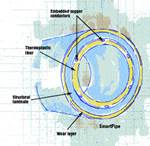RTP Niches Into Low-Pressure Applications
Wellstream (a Halliburton business unit) supplies lightweight reinforced thermoplastic pipe, or RTP, which is designed for applications intermediate between those that can use low-pressure, unreinforced thermoplastic pipe or hose, and those that require high-pressure unbonded flexible pipe. Used mainly in onsh
Wellstream (a Halliburton business unit) supplies lightweight reinforced thermoplastic pipe, or RTP, which is designed for applications intermediate between those that can use low-pressure, unreinforced thermoplastic pipe or hose, and those that require high-pressure unbonded flexible pipe. Used mainly in onshore flow line applications where the life cycle cost is less than steel pipe, RTP is available in sizes ranging from 3 inches/75 mm up to 10 inches/260 mm (ID). RTP features a polyethylene liner, a helically wrapped aramid fiber armor layer and an exterior ultraviolet-resistant thermoplastic barrier, and it offers service pressure as high as to 2,200 psi/150 bar.
Offshore applications likely will be shallow water installations where high collapse resistance is not needed. Here, RTP is more cost effective than steel pipe on a life-cycle or installed cost basis. Furthermore, RTP’s manufacturing process is straightforward and, therefore, offers the potential for near- or even onsite production with a modular manufacturing system. A joint industry project group — supported by BP, Coflexip Stena Offshore, Petrobras, Halliburton Subsea and Pipelife, among others — is currently developing guidelines for qualification and system design and has studied damage tolerance and repair issues. A draft ISO standard for RTP is in preparation (see Sidebar).
Related Content
-
Infinite Composites: Type V tanks for space, hydrogen, automotive and more
After a decade of proving its linerless, weight-saving composite tanks with NASA and more than 30 aerospace companies, this CryoSphere pioneer is scaling for growth in commercial space and sustainable transportation on Earth.
-
Sulapac introduces Sulapac Flow 1.7 to replace PLA, ABS and PP in FDM, FGF
Available as filament and granules for extrusion, new wood composite matches properties yet is compostable, eliminates microplastics and reduces carbon footprint.
-
The lessons behind OceanGate
Carbon fiber composites faced much criticism in the wake of the OceanGate submersible accident. CW’s publisher Jeff Sloan explains that it’s not that simple.












